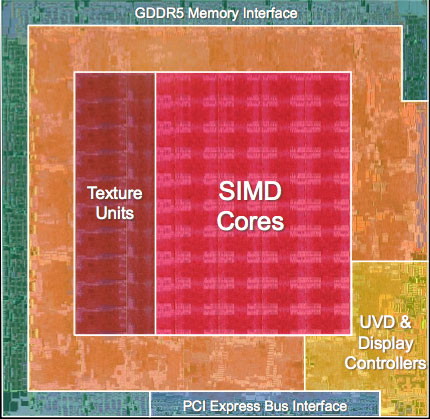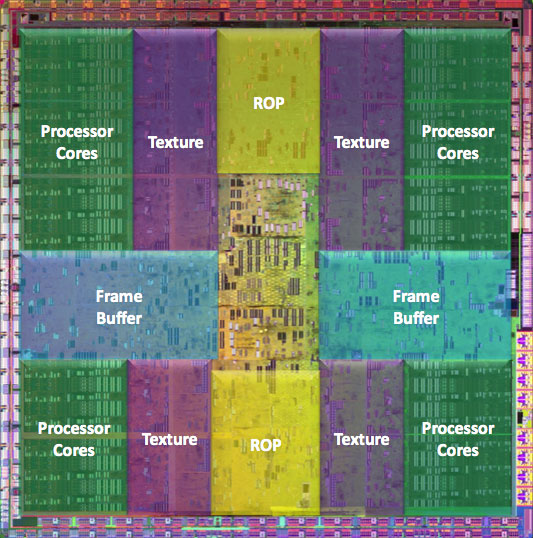The Radeon HD 4850 & 4870: AMD Wins at $199 and $299
by Anand Lal Shimpi & Derek Wilson on June 25, 2008 12:00 AM EST- Posted in
- GPUs
Wrapping Up the Architecture and Efficiency Discussion
Engineering is all about tradeoffs and balance. The choice to increase capability in one area may decrease capability in another. The addition of a feature may not be worth the cost of including it. In the worst case, as Intel found with NetBurst, an architecture may inherently flawed and a starting over down an entirely different path might be the best solution.
We are at a point where there are quite a number of similarities between NVIDIA and AMD hardware. They both require maintaining a huge number of threads in flight to hide memory and instruction latency. They both manage threads in large blocks of threads that share context. Caching, coalescing memory reads and writes, and handling resource allocation need to be carefully managed in order to keep the execution units fed. Both GT200 and RV770 execute branches via dynamic predication of direction a thread does not branch (meaning if a thread in a warp or wavefront branches differently from others, all threads in that group must execute both code paths). Both share instruction and constant caches across hardware that is SIMD in nature servicing multiple threads in one context in order to effect hardware that fits the SPMD (single program multiple data) programming model.
But the hearts of GT200 and RV770, the SPA (Steaming Processor Array) and the DPP (Data Parallel Processing) Array, respectively, are quite different. The explicitly scalar one operation per thread at a time approach that NVIDIA has taken is quite different from the 5 wide VLIW approach AMD has packed into their architecture. Both of them are SIMD in nature, but NVIDIA is more like S(operation)MD and AMD is S(VLIW)MD.

AMD's RV770, all built up and pretty
Filling the execution units of each to capacity is a challenge but looks to be more consistent on NVIDIA hardware, while in the cases where AMD hardware is used effectively (like Bioshock) we see that RV770 surpasses GTX 280 in not only performance but power efficiency as well. Area efficiency is completely owned by AMD, which means that their cost for performance delivered is lower than NVIDIA's (in terms of manufacturing -- R&D is a whole other story) since smaller ICs mean cheaper to produce parts.

NVIDIA's GT200, in all its daunting glory
While shader/kernel length isn't as important on GT200 (except that the ratio of FP and especially multiply-add operations to other code needs to be high to extract high levels of performance), longer programs are easier for AMD's compiler to extract ILP from. Both RV770 and GT200 must balance thread issue with resource usage, but RV770 can leverage higher performance in situations where ILP can be extracted from shader/kernel code which could also help in situations where the GT200 would not be able to hide latency well.
We believe based on information found on the CUDA forums and from some of our readers that G80's SPs have about a 22 stage pipeline and that GT200 is also likely deeply piped, and while AMD has told us that their pipeline is significantly shorter than this they wouldn't tell us how long it actually is. Regardless, a shorter pipeline and the ability to execute one wavefront over multiple scheduling cycles means massive amounts of TLP isn't needed just to cover instruction latency. Yes massive amounts of TLP are needed to cover memory latency, but shader programs with lots of internal compute can also help to do this on RV770.
All of this adds up to the fact that, despite the advent of DX10 and the fact that both of these architectures are very good at executing large numbers of independent threads very quickly, getting the most out of GT200 and RV770 requires vastly different approaches in some cases. Long shaders can benefit RV770 due to increased ILP that can be extracted, while the increased resource use of long shaders may mean less threads can be issued on GT200 causing lowered performance. Of course going the other direction would have the opposite effect. Caches and resource availability/management are different, meaning that tradeoffs and choices must be made in when and how data is fetched and used. Fixed function resources are different and optimization of the usage of things like texture filters and the impact of the different setup engines can have a large (and differing with architecture) impact on performance.
We still haven't gotten to the point where we can write simple shader code that just does what we want it to do and expect it to perform perfectly everywhere. Right now it seems like typical usage models favor GT200, while relative performance can vary wildly on RV770 depending on how well the code fits the hardware. G80 (and thus NVIDIA's architecture) did have a lead in the industry for months before R600 hit the scene, and it wasn't until RV670 that AMD had a real competitor in the market place. This could be part of the reason we are seeing fewer titles benefiting from the massive amount of compute available on AMD hardware. But with this launch, AMD has solidified their place in the market (as we will see the 4800 series offers a lot of value), and it will be very interesting to see what happens going forward.










215 Comments
View All Comments
calumhm - Friday, September 11, 2009 - link
i mean, ATI invented the unified pixel/shader architechture, or so i believe, and this generation they've got dx10.1 level hardware something like 7 months and counting before Nvidia have any.Also i once read an article about SLI and Crossfire, about how SLI has only one rendering type, scissors. (meaning the screen is divided in two) Whereas ATI have scissors, tiled, (so that the more demanding areas of the screen are better divided amongst the cards) and others.
Also, you can combine any HD series ATI card with any HD series card! thats way better than having to say, buy another 7800 for SLI because just one isn't doing it anymore, even though the 9800 series are out. With CFire you could add a 4870 to your old 3870!
Im currently with Nvidia (a 9600gt (found one for £60!)) but am frequently impressed by ATI.
-IS- ATI the smart customer's choice?
heaneyforestrntpe68 - Thursday, October 21, 2021 - link
well I am looking forward to a single card setup. SLI or CF is beyond the reach of my pockets. :P https://bit.ly/2Z7E1jrbillywigga - Friday, August 29, 2008 - link
im pretty shore the 4870 is low profile ive been looking everywhere for a low profile graphics card and i think i foung a high ends one unlike the geforce 8400 and the 8600 those arenot very good and they dont look good either but where do i buy the 4870Hrel - Thursday, August 21, 2008 - link
Why has there been no article comparing the 8800GT to the 9800GT? Is it just a rebrand, are there noticeable performance differences. It's 9 series, I assume it has hybrid power, but I don't know. Anandtech, PLEASE! Do an article on this.billywigga - Friday, August 29, 2008 - link
bang for the buck id get the 9800 because its newer also all the diffrence is it has more intagrated ram your saving a lot if you just get more ram to your computer.firewolfsm - Friday, August 1, 2008 - link
I'm trying to do the same benchmark for Crysis for my 4850 as I have a similar system and a fresh vista install. Just wondering what kind of driver settings you used.spikeysting - Saturday, July 19, 2008 - link
I just got it for $179 at Frys. Such a good deal.Yangorang - Tuesday, July 8, 2008 - link
Anyone tried this mod?http://www.hardforum.com/showthread.php?t=1319658">http://www.hardforum.com/showthread.php?t=1319658
jALLAD - Friday, July 4, 2008 - link
I would for sure go for the 4870. (I am a Quake Wars fan boy u see :P)But I was unsure how these would perform on Linux. Is the driver support reliable? Right now I use a 7950 NVIDIA and their support on Linux is almost shite. I was wondering whether its better or worse...
Anyone ?
KriegenSchlagen - Monday, July 7, 2008 - link
If you are a Quake Wars fan, aren't the scores higher in 3-4 GeForce SLI configs vs. Crossfire mode 4870?